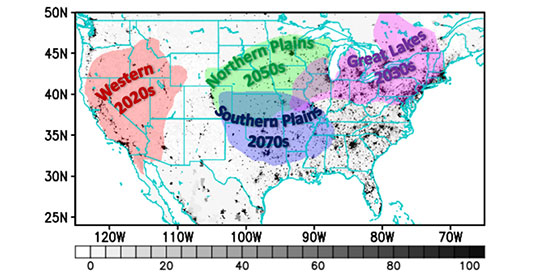 March 19, 2018 (Source: UM/RSMAS) Human-caused climate change will drive more extreme summer heat waves in the western U.S., including in California and the Southwest as early as 2020, new research shows. The new analysis of heat wave patterns across the U.S., led by scientists at the University of Miami Rosenstiel School of Marine and Atmospheric Science (UM) based Cooperative Institute for Marine and Atmospheric Science (CIMAS) and colleagues, also found that man-made climate change will be a dominant driver for heat wave occurrences in the Great Lakes region by 2030, and in the Northern and Southern Plains by 2050 and 2070, respectively.
March 19, 2018 (Source: UM/RSMAS) Human-caused climate change will drive more extreme summer heat waves in the western U.S., including in California and the Southwest as early as 2020, new research shows. The new analysis of heat wave patterns across the U.S., led by scientists at the University of Miami Rosenstiel School of Marine and Atmospheric Science (UM) based Cooperative Institute for Marine and Atmospheric Science (CIMAS) and colleagues, also found that man-made climate change will be a dominant driver for heat wave occurrences in the Great Lakes region by 2030, and in the Northern and Southern Plains by 2050 and 2070, respectively.
Man-made climate change is the result of increased carbon dioxide and other human-made emissions into the atmosphere.
“These are the years that the human contributions to climate change will become as important as natural variability in causing heat waves,” said lead author Hosmay Lopez, a CIMAS meteorologist based at NOAA’s Atlantic Oceanographic Meteorological Laboratory. “Without human influence, half of the extreme heat waves projected to occur during this century wouldn’t happen.”
The study, published in the March 19, 2018 online issue of the journal Nature Climate Change, has important implications for the growing populations in these regions since heat waves, which are the number one cause of weather-related deaths in the United States, have already increased in number and severity in recent decades and are projected to rise well into the 21st century.











